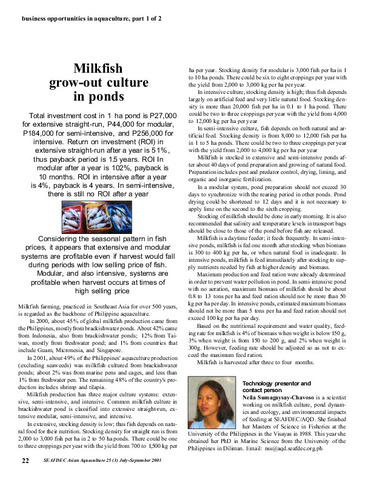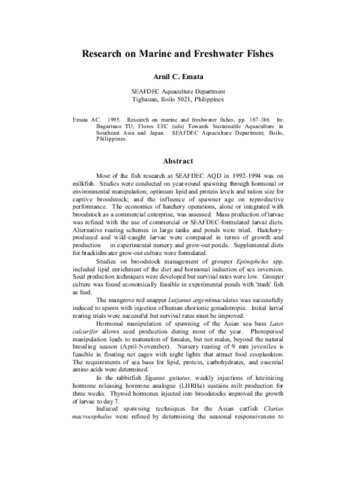Use of plant proteins in aquaculture feed for top five commodities in ASEAN member states
- Global styles
- MLA
- Vancouver
- Elsevier - Harvard
- APA
- Help

Date
2015Author
Page views
24,289ASFA keyword
AGROVOC keyword
Taxonomic term
Metadata
Show full item record
Share
Abstract
Fish production from aquaculture in Asia has steadily increased during the past decade. In 2012, Asia s share in the total world aquaculture production was about 89% with 60 M metric tons valued at US$ 120 B. ASEAN Member States such as Viet Nam, Indonesia, Thailand, Myanmar, and the Philippines are among the top producers in Asia contributing 9 M metric tons of production from aquaculture valued at US$ 19 B (FAO, 2014). To sustain the production and profitability of aquaculture operations, reducing costs is needed mainly through feeds and feeding which represent up to 60% of operational costs. Reductions in feeding costs can be realized through optimizing nutrient levels of diets, feeding strategies, and by using plant protein sources as fish meal substitutes. As more intensive methods for production of the top five commodities (carps, tilapia, milkfish, catfish, and Pangasius sp.) become popular in ASEAN Member States, practical feeds need to be formulated using plant protein sources that are locally available. Plant protein sources such as soy proteins and corn gluten have been used as partial or total replacements for fish meal quite extensively in aquafeed for the top aquaculture commodities because of their high protein content (40-60%) and good digestibility. Other alternative dietary protein sources with emphasis on oilseed meals, peas and other leguminous seed meals, leaf meals from terrestrial plants, aquatic plants, plant protein concentrates, single cell proteins, cereal by products, fermentation and other products have been or are currently being evaluated as fish meal substitutes for their nutritive values, inclusion levels, constraints in processing mainly to reduce the effects of anti-nutritional factors as well as economic value. The proper use of these ingredients would promote good fish growth, survival, production, and boost the income of small scale farmers. Testing of aquaculture feeds containing these local ingredients will help the regional as well as worldwide research and development efforts and ultimately benefit the local small scale fish farmers and other stakeholders.
Suggested Citation
Coloso, R. M. (2015). Use of plant proteins in aquaculture feed for top five commodities in ASEAN member states. In M. R. Catacutan, R. M. Coloso, & B. O. Acosta (Eds.), Development and Use of Alternative Dietary Ingredients or Fish Meal Substitutes in Aquaculture Feed Formulation : Proceedings of the ASEAN Regional Technical Consultation on Development and Use of Alternative Dietary Ingredients or Fish Meal Substitutes in Aquaculture Feed Formulation, 9-11 December 2014, Nay Pyi Taw, Myanmar (pp. 79-88). Tigbauan, Iloilo, Philippines: Aquaculture Department, Southeast Asian Fisheries Development Center.
Type
Conference paperISBN
9789719931058
Related items
Showing items related by title, author, creator and subject.
-
Management of feeding aquaculture species
Alava, Veronica R. (Aquaculture Department, Southeast Asian Fisheries Development Center, 2002)This chapter teaches the reader to: differentiate the different feeding strategies in pond culture; learn feeding management methods such as stock sampling and record keeping, calculating daily feed ration, choosing ... -
Milkfish grow-out culture in ponds
Sumagaysay-Chavoso, Neila (Aquaculture Department, Southeast Asian Fisheries Development Center, 2003)Milkfish farming is regarded as the backbone of Philippine aquaculture. In 2001, nearly 50% of the Philippines' aquaculture production was milkfish cultured from brackishwater ponds. It has 3 major culture systems: extensive; ... -
Research on marine and freshwater fishes
Emata, Arnil C. (Aquaculture Department, Southeast Asian Fisheries Development Center, 1995)Most of the fish research at SEAFDEC AQD in 1992-1994 was on milkfish. Studies were conducted on year-round spawning through hormonal or environmental manipulation; optimum lipid and protein levels and ration size for ...






